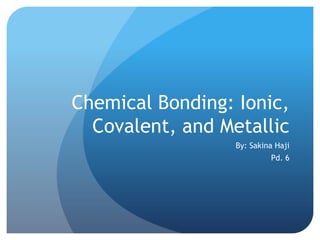
Chemical Bonding Types: Ionic, Covalent & Metallic
- 1. Chemical Bonding: Ionic, Covalent, and Metallic By: Sakina Haji Pd. 6
- 2. What is a Chemical Bond? A chemical bond holds two atoms together. It is formed by the attraction of a positive and a negative ion or by the attraction of a positive nucleus to negative electrons. Atoms form chemical bonds to get eight valence electrons, to complete the octet rule and to become stable. 3 types: Ionic, Covalent, and Metallic
- 3. Ionic Bonds Ionic bonds form between cations (metals) and anions (nonmetals). The metal transfers its valence electron to the nonmetal. The nonmetal accepts the valence electrons and turns into a negative ion, while the metal becomes a positive ion. Arranged in a pattern of a crystal lattice High melting and boiling points Hard, rigid, and brittle
- 4. Ionic Bonds: Energy The formation of ionic compounds is exothermic. The energy required to separate ions is called the lattice energy. The more negative the lattice energy, the stronger the force of attraction. Lattice energy of smaller compounds is more negative than that of larger compounds because the nucleus holds the valence electrons more closely together.
- 5. Covalent Bonds Instead of transferring electrons, atoms share electrons. If one pair of electrons are shared, a single bond is formed (Group 17 elements form single bonds). If multiple pairs of electrons are shared, double and triple bonds can be formed (carbon, nitrogen, oxygen, and sulfur usually form multiple bonds).
- 6. Covalent Bonds: Sigma vs. Pi Single covalent bonds are called sigma bonds. Occurs when the electron pair is shared in an area centered between the two atoms. A sigma bond results if the valence atomic orbitals overlap end to end. A pi bond is formed when parallel orbitals overlap to share electrons. The shared electron pair occupies the space above and below the place where the atoms are joined. A double bond has one sigma and one pi bond. A triple bond has one sigma bond and two pi bonds.
- 7. Covalent Bonds: Energy Bond length: Distance between the atoms Bond dissociation energy: Amount of energy required to bread a covalent bond The smaller the bond length, the greater the bond dissociation energy, and vice versa.
- 9. Metallic Bonds When metals bond together to complete the octet rule. All metal atoms contribute their valence electrons to form a sea of electrons. Electrons are free to move b/w the atoms.
- 10. Metallic Bonding: Alloys An alloy is a mixture of elements that has metallic properties. Properties of alloys are different from those of the elements in it. Alloys most commonly forms when elements involved are similar in size or the atoms of one element are considerably smaller than the atoms of the other. There are two types of alloys, substitutional and interstitial.
- 11. Metallic Bonds: Energy Metallic bonds are weak and little energy is needed to break the bonds. Therefore, they have high melting points Because the electrons are mobile, they transfer heat more efficiently and, therefore, are better conductors.
- 12. Conclusion Elements bond to become stable. Elements bond to have 8 valence electrons. 3 types of bonds: Ionic, Covalent, Metallic In ionic bonds, one element gives its electrons to another element. Covalent bonds are the strongest bonds. Elements share electrons. Metallic bonds are the weakest bonds. Elements are in a sea of electrons